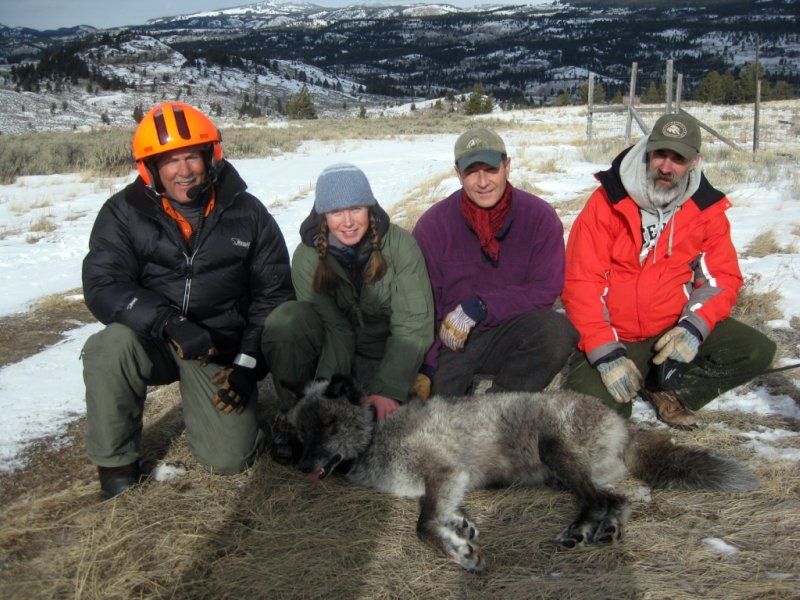The Absaroka Wolf-Cattle project was created to evaluate wolf habitat selection and predation in a multiple-use landscape in the Absaroka Mountains of Wyoming, an area characterized by high levels of wolf-cattle conflict and a changing distribution of migratory and nonmigratory elk. We have been conducting this work in collaboration with the Wyoming Game and Fish Department and the U.S. Fish and Wildlife Service and have received much support from participating ranchers, sportsmen, U.S.D.A. Wildlife Services, and U.S. Forest Service personnel.
The study area spans from Cody, Wyoming to the northeast corner of Yellowstone National Park (YNP) and includes the seasonal ranges of the partially migratory Clark’s Fork elk herd and four resident wolf packs. Prior studies indicate that the distribution and abundance of elk can influence not only wolf movements but also cattle depredation patterns. Three of our focal packs –Sunlight, Beartooth and Hoodoo – rely on the fully migratory portion of the Clark’s Fork elk herd in winter. When these elk undergo a 20-30 mile migration into the upper Lamar River in YNP during the summer, the wolf packs appear to change their habitat use patterns and prey choices. In contrast, a fourth pack – the Absaroka Pack – relies on the nonmigratory portion of the elk herd that remain year-round in the foothills of the Absaroka Front. These elk often mingle in pastures with domestic cattle during the summer. By comparing the movement and predation patterns of these two different types of wolf packs, we hope to better understand the influence of migratory prey on the ecology and conservation of wolves.
In the field, we have used GPS tracking of wolves and elk to assess the influence of elk distribution and migratory status on 1) wolf habitat use in summer and winter, and 2) the incidence and patterns of predation on livestock vs. wild ungulates. To characterize pastures with re-occurring livestock depredations each year, we located cattle carcasses using wolf GPS location clusters and reports from cooperating ranchers and agencies.
In areas with recolonizing wolf populations, predicting wolf movements and conflicts can be challenging. Large-scale shifts in the distribution of wolves’ prey, including changing migratory patterns, further complicate efforts to sustain wolves and minimize conflicts. Wildlife management agencies often gather long-term information on the distribution and abundance of wild ungulates, and our study is providing some insights into how the distribution of such prey populations can influence the establishment patterns and seasonal movements of wolves. A primary focus of this work is to develop the means to characterize the risk of wolf depredation for cattle pastures, dependent on whether they occur where elk are migratory versus resident.
Contact
Abby Nelson, Wolf Management Specialist
Montana Fish, Wildlife and Parks
Livingston, MT
abnelson@mt.gov
cell: (406) 600-5150
Mike Jimenez, Wyoming Wolf Project Leader
U.S. Fish & Wildlife Service
P.O. Box 2645
Jackson, WY 83001
mike_jimenez@fws.gov
office: (307) 733-7096
cell: (307) 330-5631
Doug McWhirter, Wildlife Biologist
Wyoming Game & Fish Department
2820 State Highway 120
Cody, WY 82414
doug.mcwhirter@wgfd.state.wy.us
office: (307) 527-7125
Timeline
This project was initiated in 2007, with two field seasons designed to locate wolf kill sites via GPS cluster-searching during July-September 2007 and July-October 2008 (augmented by depredation reports for the period 2007-2010). The data collected to assess wolf habitat selection in relation to migratory patterns of elk were collected via wolf and elk GPS collars deployed between 2007 and 2010. All the GPS collars used in this project were retrieved from the field by mid-2010. Analyses were completed in August 2011.
Project Lead
Abby Nelson currently works as a Wolf Management Specialist for Montana Fish, Wildlife, and Parks. Abby received her undergraduate degree from Colorado College in 2002, and since that time has worked in Colorado, Montana, and Wyoming on various wildlife related projects. MORE »

Timeline
Field work on the Absaroka Elk Ecology Project began in January 2007 with the capture and collaring of 60 adult female Clarks Fork elk and 6 wolves in the packs that hunt them. In winter 2008, additional GPS collars were added, and a series of recaptures was initiated in order to monitor elk body fat levels and reproduction. Additional wolves were captured and collared annually throughout the course of our field work. Field crews also completed three winter field seasons during 2008-2010 monitoring the time budgets and grouping behavior of collared elk. A companion project, conducted by Dan Tinker and Sara Beaver of the Department of Botany at the University of Wyoming, collected information on habitat quality of migrant and resident elk summer range during 2008 and 2009. The bulk of the field work on the Absaroka Elk Ecology Project was completed in spring and summer 2010, when elk GPS collars automatically dropped off. Several remaining wolf GPS collars dropped off in spring 2011. The project is now largely complete, though some additional analyses and reporting will continue into 2013.
Funding & Partners
Wyoming Animal Damage Management Board · Wyoming Game & Fish Department · U.S. Fish & Wildlife Service · Community Forestry & Environmental Research Partnerships · University of Wyoming Plummer Scholarship · University of Wyoming Haub School Summer Research Grant










